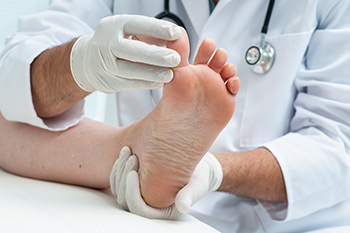NJ (908) 688-5577
NY (212) 737-2528

Athlete's foot, a common fungal infection that affects the skin of the feet, can be influenced by various environmental factors. Moisture plays a significant role in its development, as the fungus thrives in warm, damp conditions. Sweaty feet trapped in tight, poorly ventilated shoes or damp environments, like locker rooms and communal showers, create an ideal breeding ground for the fungus. Therefore, keeping your feet dry and clean is essential in preventing athlete's foot. Furthermore, sharing contaminated surfaces, such as towels or footwear, can contribute to its spread. It is critical to practice good foot hygiene and avoid sharing personal items with infected individuals to reduce the risk. Preventive measures include wearing breathable shoes, changing socks regularly, and using antifungal powders or creams. Proper foot hygiene and avoiding exposure to fungus-prone areas are key in reducing the likelihood of athlete's foot. If you have developed athlete’s foot, it is suggested that you schedule an appointment with a podiatrist for a proper diagnosis and treatment.
Athlete’s Foot
Athlete’s foot is often an uncomfortable condition to experience. Thankfully, podiatrists specialize in treating athlete’s foot and offer the best treatment options. If you have any questions about athlete’s foot, consult with Glenn Davison, DPM from Advanced Podiatry. Our doctor will assess your condition and provide you with quality treatment.
What Is Athlete’s Foot?
Tinea pedis, more commonly known as athlete’s foot, is a non-serious and common fungal infection of the foot. Athlete’s foot is contagious and can be contracted by touching someone who has it or infected surfaces. The most common places contaminated by it are public showers, locker rooms, and swimming pools. Once contracted, it grows on feet that are left inside moist, dark, and warm shoes and socks.
Prevention
The most effective ways to prevent athlete’s foot include:
Symptoms
Athlete’s foot initially occurs as a rash between the toes. However, if left undiagnosed, it can spread to the sides and bottom of the feet, toenails, and if touched by hand, the hands themselves. Symptoms include:
Diagnosis and Treatment
Diagnosis is quick and easy. Skin samples will be taken and either viewed under a microscope or sent to a lab for testing. Sometimes, a podiatrist can diagnose it based on simply looking at it. Once confirmed, treatment options include oral and topical antifungal medications.
If you have any questions, please feel free to contact our offices located in Union, NJ and New York . We offer the newest diagnostic and treatment technologies for all your foot care needs.